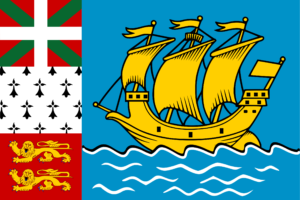Saint Pierre and Miquelon is an archipelago in the North Atlantic Ocean. The islands are now French territory. Spaniards and Portuguese settled here temporarily in his 16th century. The construction was done at this location because the area was a thriving fishing industry.
By the 17th century, the French had established a settlement on the island. Over the years, Britain and France fought over the island, changing ownership several times until France finally gained permanent control.
| Capital | Saint-Pierre |
| Population | 5836 (Source: 2023 worldometer) |
| Major Cities | Saint-Pierre (capital), Miquelon-Langlade |
| Borders | maritime boundary with Canada |
| Gross Domestic Product (GDP) | $261.3 million (2022 wikipedia) |
| Currency | euro (EUR) |

Saint Pierre and Miquelon Major Industries: fish processing and supply base for fishing fleets; tourism
Saint Pierre and Miquelon Agricultural Products: vegetables; poultry, cattle, sheep, pigs; fish
Saint Pierre and Miquelon Natural Resources: fish, deepwater ports
Saint Pierre and Miquelon Major Exports: fish and fish products, soybeans, animal feed, mollusks and crustaceans, fox and mink pelts
Saint Pierre and Miquelon Major Imports: meat, clothing, fuel, electrical equipment, machinery, building materials
Total Size of Saint Pierre and Miquelon: 242 km² (source: 2022 wikipedia)
Geographical Low Point of Saint Pierre and Miquelon: Atlantic Ocean 0 m
Geographical High Point of Saint Pierre and Miquelon: Morne de la Grande Montagne 240 m
Climate of Saint Pierre and Miquelon: cold and wet, with much mist and fog; spring and autumn are windy
General Terrain of Saint Pierre and Miquelon: mostly barren rock
World Region or Continent of Saint Pierre and Miquelon: Central America
Geographical Coordinates: 46 50 N, 56 20 W
Saint Pierre and Miquelon Government Type: NA
Saint Pierre and Miquelon Nationality: Frenchman(men), Frenchwoman(women)
Saint Pierre and Miquelon National Holiday: Bastille Day, 14 July (1789)
Saint Pierre and Miquelon Independence: none (territorial collectivity of France; has been under French control since 1763)
Saint Pierre and Miquelon National Symbol: 16th-century sailing ship
Saint Pierre and Miquelon National Anthem or Song: note:?as a collectivity of France, La Marseillaise is official (see France)
Saint Pierre and Miquelon Languages Spoken: French (official)
Saint Pierre and Miquelon Religions: Roman Catholic 99%
Britain and France fought over these islands for over a century. The British occupied both areas in 1713, 1778, 1794, 1803 and 1815. During these years the French reclaimed the land, and in fact France has maintained control since her 1816.
Saint-Pierre is the name of her one of her eight islands that make up the common territory, as well as the name of her capital. Only two of these islands are inhabited. Interestingly, the other is Miquelon.
Saint Pierre and Miquelon have their own her half hour time zone. 30 minutes from Newfoundland. This means that New Year’s celebrations in these islands begin he half an hour earlier than in the rest of North America. It is also important that travelers heading west from Fortune to Saint-Pierre should adjust their clocks in advance.
The euro is the dominant currency in the region thanks to its continued links with France. Canadian dollars are also accepted.
The main language on the islands is French. English is also widely spoken here, but food and wine are largely influenced by French tastes.
Christianity is predominantly Roman Catholic on Saint Pierre and Miquelon.
These islands are located in the Gulf of St. Lawrence at the entrance to Fortune Bay. People use ferries to travel to and from the settlements.
Brest, France is the closest French city to the island. But the distance is long at 2,373 miles (3,819 km)! This is one of the most remote areas in France.
About 600 shipwrecks have been documented between Langland and Saint-Pierre in the 19th century. For this reason, the area has earned the rather nasty nickname of “Hell’s Mouth”. Luckily, that reputation has changed a lot in the last few decades.
During the 1920s and America’s famous Prohibition era, the island became a hub for liquor smuggling. Infamous gangster Al Capone frequented the area, staying at a hotel which is still open for business! Hotel Robert has attracted historians, film makers, tourists and businesspeople for decades!
A major annual attraction of the area is whale watching in spring. Migrating whales are studied and filmed by nature lovers and scientists. Their activity is also a good indicator of species health and water body conditions.

